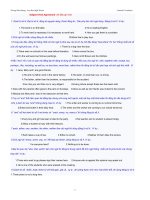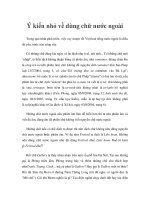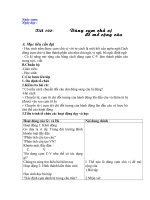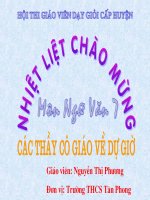GHI NHO VE CUM CHU VI
Bạn đang xem bản rút gọn của tài liệu. Xem và tải ngay bản đầy đủ của tài liệu tại đây (91.22 KB, 2 trang )
Truong Huu Huong - Lao Bao High School Limited Circulation
Subject-Verb Agreement -20 điều ghi nhớ
1. Danh từ số ít ,Đại từ số ít, động từ nguyên dạng, Danh động từ , Câu phụ làm chủ ngữ dùng Động từ số ít .Ví dụ :
1.The book is on the table. 2.He is reading English.
3.To work hard is necessary.It is necessary to work hard. 4.How you get there is a problem.
2.Chủ ngữ số nhiều dùng động từ số nhiều . Children like to play toys.
3.Trong câu đảo ,động từ thống nhất với chủ ngữ ở phía sau của nó.Ví dụ mở đầu bằng “here,there” thì “be” thống nhất với số
của chủ ngữ phía sau .Ví dụ : 1.There is a dog near the door.
2.There were no schools in this area before liberation. 3.Here comes the bus.
4.On the wall were two famous paintings. 5.Here is Mr Brown and his children.
4.Nếu “and” nối 2 cái có quan hệ đẳng lập thì động từ dùng số nhiều .Nếu sau chủ ngữ là : with, together with, except, but,
perhaps , like, including, as well as, no less than, more than, rather than thì động từ chỉ cần phù hợp với chủ ngữ thứ nhất . Ví
dụ : 1.Jane, Mary and I are good friends.
2.He and my father work in the same factory. 3.His sister, no less than you, is wrong.
4.The father, rather than the brothers, is responsible for the accident.
5.He, like you and Xiao Liu is very diligent. 6.Every picture except these two has been sold.
7.Alice with her parents often goes to the park on Sundays. 8.Alice as well as her friends was invited to the concert.
9.Nobody but Mary and I was in the classroom at that time.
5 Tuy có “and” thể hiện quan hệ đẳng lập nhưng chỉ cùng một người ,một vật hay một khái niệm thì động từ vẫn dùng số ít
.Chú ý danh từ sau “and” không dùng mạo từ .Ví dụ : 1.The writer and worker is coming to our school tomorrow.
2.Bread and butter is their daily food. 3.The writer and the worker are coming to our school tomorrow.
6. “and” nối hai danh từ số ít mà trước có “ each, every, no, many a” thì dùng động từ số ít .
1.Every boy and girl has been invited to the party. 2.No teacher and no student is absent today.
3.Many a student is busy with their lessons.
7.each, either, one, another, the other, neither làm chủ ngữ thì dùng động từ số ít. Ví dụ :
1.Each takes a cup of tea. 2.Either is correct. 3.Neither of them likes this picture.
8.Chủ ngữ do “every, some, any, no” kết hợp tạo thành ,dùng động từ số ít .Ví dụ :
1.Is everyone here? 2.Nothing is to be done.
9.Đại từ quan hệ “who, that, which” làm chủ ngữ thì động từ trong mệnh đề tính ngữ thống nhất với từ phía trước mà chúng
thay thế .Ví dụ :
1.Those who want to go please sign their names here. 2.Anyone who is against this opinion may speak out.
3.He is one of the students who were praised at the meeting.
10.Danh từ số nhiều ,hoặc nhóm từ chỉ thời gian ,giá cả , cự ly , đo lường được nhìn như một chỉnh thể ,thì dùng động từ số ít
1.Three years is not a long time.
- 1 -
Truong Huu Huong - Lao Bao High School Limited Circulation
2.Ten dollars is what he needs. 3.Five hundred miles is a long distance.
11.Danh từ riêng có hình thức số nhiều được nhìn nhận như một chỉnh thể chỉ tên người ,địa điểm , quốc gia , tổ chức , sách
báo thì dùng động từ số ít .
1.The United States is in North America. 2.The United Nations has passed a resolution(.....)
3“The Arabian Nights” is an interesting book.
12.Khi một số danh từ chỉ một tập hợp như là :family, team, group, class, audience(người xem),government làm chủ
ngữ ,Nếu nhìn nhận như một chỉnh thể thì dùng động từ số ít .Nếu nhấn mạnh ở sự tập hợp của các thành viên thì dùng động
từ số nhiều .
1.My family is going to have a long journey. (cả gia đình) 2.My family are fond of music. (các thành viên trong gia
đình 3.The class has won the honour. 4.The class were jumping for joy.
13.all, more, most, some, any, none, half, the rest làm chủ ngữ có thể chỉ số nhiều ,có thể chỉ số ít vì vậy hình thức của động
từ phải căn cứ vào tình hình cụ thể mà quyết định .
1.All of the apple is rotten. (cả một quả) 2.All of the apples are rotten. (tất cả các quả táo )
3.Most of the wood was used to make furniture .
14. the + tính từ (hoặc phân từ) thường chỉ một lớp cùng loại nên dùng động từ số nhiều . Nhưng nếu chỉ một khái niệm trừu
tượng thì đông từ dùng số ít . 1.The young are usually very active.
2.The wounded are being taken good care of here now.
15.Cấu trúc ...or ..., either…or…, neither…nor…, whether…or, not only…but (also) làm chủ ngữ,thì động từ do chủ ngữ phía
sau quyết định.
1.Either you or I am going to the movies. 2.Not only you but also he is wrong.
16.danh từ không đếm được làm chủ ngữ dùng động từ số ít.
1.Water is a kind of matter. 2.The news at six o’clock is true.
17.Danh từ chỉ một tập hợp people, police ,cattle làm chủ ngữ dùng động từ số nhiều .
1.The police are searching for him. 2The cattle are grassing .
18. “population” có nghĩa là “dân số” thì dùng động từ số ít ,Nếu có nghĩa là “số người” thì dùng động từ số nhiều .
1.The population of China is larger than that of Japan.
2.One third of the population here are workers.
19. the number of + Danh từ số nhiều để chỉ “con số” thì dùng động từ số ít a (large / great) number of + Danh từ số nhiều để
chỉ “nhiều...”thì dùng động từ số nhiều . 1.The number of the students in our school is increasing year after year.
2 . A number of students have gone for an outing.
20. means, politics, physics, plastics... làm chủ ngữ dùng động từ số ít .
- 2 -









